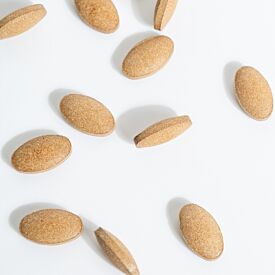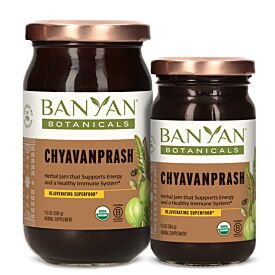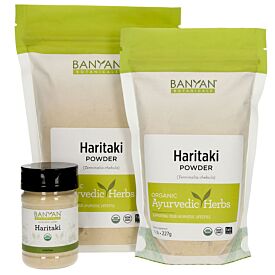USDA Certified Organic
When you purchase certified organic herbs from Banyan Botanicals, you can be confident that you are making a healthful choice, while also contributing to a healthier planet. In order to meet the USDA’s stringent organic standards our entire line of supply is regularly inspected by independent 3rd party certifying agencies.
Learn MoreTraditional Ayurvedic blend to support digestion, elimination, and a healthy gut microbiome*
Free shipping on orders over $60
Satisfaction Guarantee - 90 Day Return Policy
This simple yet potent blend of three fruits is perhaps the most beloved Ayurvedic formula. Renowned for its ability to both detoxify and replenish the system, Triphala gently supports digestion and a healthy gut microbiome while it helps relieve occasional constipation and supports regularity. Triphala powder is the most traditional and versatile way to use this blend.*
- Natural source of antioxidants*
- Assists natural internal cleansing*
- Gently maintains regularity*
- Nourishes and rejuvenates the tissues*
- Supports healthy digestion and absorption*
Triphala isn't intended to treat chronic constipation, which can be a sign of an underlying imbalance and may require practitioner support.
California Customers: WARNING
Take ¼ to ½ teaspoon with warm water, once or twice daily, on an empty stomach at bedtime or upon waking, or as directed by your health practitioner.
Please consult with your health care practitioner prior to the use of this product if you are pregnant or nursing, taking medications, or have a medical condition. Keep out of the reach of children.
Amalaki fruit (Emblica officinalis)+, Bibhitaki fruit (Terminalia belerica)+, Haritaki fruit (Terminalia chebula)+.
+Certified Organic
This product is organically grown and processed in accordance with the USDA's National Organic Program (NOP).
This item contains no animal products and is suitable for vegetarians and vegans.
Ayurvedic Energetics:
- Rasa (taste): sweet, sour, pungent, bitter, astringent
- Virya (action): neutral
- Vipaka (post-digestive effect): sweet
- Doshas (constitutions): Balancing for vata, pitta, and kapha
Herbal Highlights
-

Amla Fruit
Amla's antioxidant, vitamin C, and polyphenol content contribute to its cleansing quality and ability to support a healthy digestive tract.*
-

Bibhitaki Fruit
The fleshy fruits of these large deciduous trees are prized in traditional Ayurvedic herbalism for their detoxifying and rejuvenating nature.*
-

Haritaki Fruit
Haritaki fruit is naturally rich in tannins and other important bioactive compounds, including chebulagic acid, chebulinic acid, and corilagin.
- What is in the Triphala formula?
- How is Banyan's Triphala superior?
- How do I take Triphala? At what time of the day, and do I take it with or without food?
- How much Triphala should I take?
- How soon after I start taking Triphala can I expect results?
- How long can I take Triphala?
- Can I take Triphala while I'm menstruating?
- Can I take this while I'm pregnant or nursing?
- What if I'm taking another herb or medication?
- Are there any herbs or products that would complement Triphala?
- What are some effects of Triphala that may be bothersome to my predominant dosha or cause other imbalance based on my constitution?
- Is Triphala powder the best way to ingest my herbs?
1. What is in the Triphala formula?
Triphala is equally composed of three fruits, and the literal translation of the name is “tri” for three and “phala” for fruits. Each of these fruits has an affinity for a specific dosha: haritaki pacifies vata, amalaki pacifies pitta, and bibhitaki pacifies kapha. Because of this it is considered “tridoshic” (which means it is balancing for all doshas).
If you are unsure what your constitution is, or how to determine imbalances, take our Ayurvedic Profile™ Quiz.
2. How is Banyan’s Triphala superior?
Our mission is to help you achieve and maintain health and well-being, and we passionately believe that offering the highest quality Triphala is crucial to fulfilling our mission to you. We are involved in every step of the way to ensure that what you receive is superior– from working with the farmers that grow and nurture the herbs to rigorously testing the safety of each and every batch we sell. Our Triphala is certified organic, organically farmed, sustainably sourced, fairly traded, and stringently tested for quality.
3. How do I take Triphala? At what time of the day, and do I take it with or without food?
What is your intention with taking Triphala? For support and rejuvenation, taking the powder at night before bed is best. For detoxification, it is most effective to take on an empty stomach either before bed or upon awakening. If you have a sensitive stomach, it may be more comfortable to take the powder with food or after you have eaten.
The most important component is to simply take your herbs! With many of the herbs and formulas we carry, it is far more important to pick a time that is convenient for you than to be overly concerned about precisely when to take them. We also encourage you to experiment to find the time that works best for you: Ayurveda honors the uniqueness in each of us, and while one time may work for one person, a different time may work better for you.
4. How much Triphala should I take?
Our general recommendation is to take ¼ to ½ teaspoon with warm water, once or twice daily. You may see best results by committing to taking Triphala once daily, right before bed or upon rising. You may increase or decrease the amount you take depending on how you respond to Triphala. Listen to your body – it will be your best guide.
If you don’t see results within a couple weeks, it is completely safe to increase the amount within the recommended dosage. The ingredients are three fruits – if you happen to take more than your body needs, it may result in loose motions. Lower your dosage until you find a comfortable balance. If you need more guidance, work with a practitioner.
5. How soon after I start taking Triphala can I expect results?
Most people experience a more complete evacuation of the bowels within the first few days of taking Triphala. If you have a more chronic imbalance, it may take a little longer for results to be noticeable. For some people when detoxification begins, the bowels may be a little looser than normal. This is a common sign of cleansing and your bowel movements will return to normal as balance is achieved.
As a general guideline, try it for at least 4–6 weeks. This will give the herbs time to penetrate all the tissue layers. It can also be useful to check in with yourself on a daily basis to help be aware of the subtle energies of the herbs. How was your digestion today? How was your energy? Not only will you notice the herbs working but you will learn how subtle adjustments of your diet, routine, and lifestyle make a difference to your well-being.
6. How long can I take Triphala?
Triphala is composed of three fruits – haritaki, amalaki, and bibhitaki. It is not uncommon to take Triphala for many, many years. Some notice an evolution in the way Triphala tastes and the subtle energies of the formula when taking it for a long time. For example, it may initially taste bitter. After a while, as balance is attained, the other tastes may emerge.
7. Can I take Triphala while I’m menstruating?
You can certainly take this during menstruation, and it is possible that Triphala may help bolster healthy elimination and support a healthy flow while you are menstruating. For those who experience irregular elimination during menstruation, Triphala can be an especially great companion for you. Of course, since each and every situation is unique, we do also encourage you to first speak with a practitioner if you have questions about your menstruation and how Triphala can best support you.
8. Can I take this while I’m pregnant or nursing?
Triphala is not recommended during pregnancy due to haritaki, which has a laxative effect. Consult your practitioner if you would like to take this while you are nursing.
9. What if I’m taking another herb or medication?
Herbs often work synergistically, meaning that they can complement each other and work in harmony. These herbs have also been used for thousands of years to help people regain balance. However, it is best to talk with your practitioner if you want more clarity, you are already taking other herbs or a medication, or if you have any medical conditions.
10. Are there any other herbs or products that would complement Triphala?
Triphala is arguably the most beloved and recommended formula in Ayurveda. Since it is tridoshic (it balances all doshas), it is often used on its own or with other herbs. If you are interested in taking other Ayurvedic herbs or formulas with your Triphala to help bring balance to specific areas, the herbs will work synergistically to bring overall balance. For example, trikatu (Kapha Digest) and Triphala can be a great combination if you are looking to enkindle your digestive fire or to support your lungs if there is a kapha imbalance. If you tend toward vata imbalance with your elimination, taking additional haritaki with your triphala will help to balance vata while supporting healthy and regular bowel movements. Likewise, additional amalaki with your Triphala helps pacify excess pitta.
If you would like more suggestions on different herbs in combination with Triphala to help balance specific imbalances, we recommend these reference books, Ayurvedic Medicine by Sebastian Pole and The Yoga of Herbs by Drs. Lad and Frawley.
11. What are some effects of Triphala that may be bothersome to my predominant dosha or cause other imbalance based on my constitution?
This is a very balancing and well-rounded formula for all doshas: each fruit corresponds with a dosha (haritaki for vata, amalaki for pitta, and bibhitaki for kapha). It also has five of the six tastes – all but salty – and it is believed that the tastes are a major component in its effectiveness with bringing balance throughout the body.
12. Is powder the best way to ingest my herbs?
Our bulk herbs are the most traditional and Ayurvedic mode of intake. Triphala powder allows you to taste the herbs, and taste is incredibly important in Ayurveda (here is an article for more information on tastes). Plus, it's versatile! Triphala powder can be used topically, or you can choose to mix them with other powdered herbs to create your own formula. That said, tablets and liquid extracts also have many merits and have beneficial Ayurvedic qualities. One form isn't necessarily better than another—it simply depends on what supports your unique situation best!

Environmentally responsible practices support the long term well-being of the plants and ecosystems we source from.
Organic herbs are grown with the use of renewable resources, contributing to both individual and planetary health.
Equitable supply chains ensure the social and economic well-being of our small farmers, producers, and suppliers.

Stay Balanced with
Banyan AutoShip
How It Works:
- Get your favorite products discounted and delivered automatically.
- Manage frequency, delivery, and quantity anytime through your account.
- Receive an email reminder before each delivery.
- Adjust or reschedule orders easily online.





















